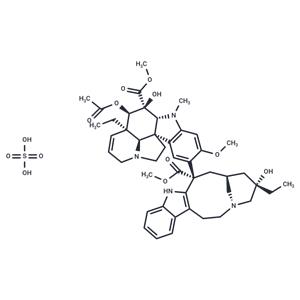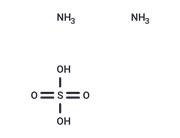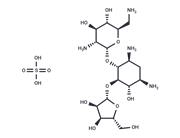| Name | Vinblastine sulfate |
| Description | Vinblastine sulfate (Vincaleukoblastine sulfate salt) can inhibit the formation of microtubule, it also inhibits nAChR(IC50=8.9 uM). |
| Cell Research | Six-well treatment plates are set up that contained 5 × 104 cells/mL in each well, suspended in 3 mL culture medium, and these are treated with vinblastine for 3 h followed by 21 h growth. (Only for Reference) |
| Kinase Assay | Cell based receptor autophosphorylation assays: Autophosphorylation of PDGFR family kinase assays are cell-based enzyme-linked immunosorbent (ELISA) assays using CHO cells expressing wild-type PDGFRβ, chimeric protein PDGFRβ/c-Kit, and PDGFRβ/Flt3 which contain the extracellular and transmembrane domains of PDGFRβ and the cytoplasmic domain of c-Kit, and Flt-3. Cells are grown to confluency in 96-well microtiter plates under standard tissue culture conditions, followed by serum starvation for 16 hours. Briefly, quiescent cells are incubated at 37 °C with increasing concentrations of Tandutinib for 30 minutes followed by the addition of 8 nM PDGF-BB for 10 minutes. Cells are lysed in 100 mM Tris, pH 7.5, 750 mM NaCl, 0.5% Triton X-100, 10 mM sodium pyrophosphate, 50 mM NaF, 10 μg/mL aprotinin, 10 μg/mL leupeptin, 1 mM phenylmethylsulfonyl fluoride, 1 mM sodium vanadate, and the lysate is cleared by centrifugation at 15,000 g for 5 minutes. Clarified lysates are transferred into a second microtiter plate in which the wells are previously coated with 500 ng/well of 1B5B11 anti-PDGFRβ mAb and then incubated for 2 hours at room temperature. After washing three times with binding buffer (0.3% gelatin, 25 mM HEPES, pH 7.5, 100 mM NaCl, 0.01% Tween 20), 250 ng/mL of rabbit polyclonal anti-phosphotyrosine antibody is added and plates are incubated at 37 °C for 60 minutes. Subsequently, each well is washed three times with binding buffer and incubated with 1 μg/mL of horseradish peroxidase-conjugated anti-rabbit antibody at 37 °C for 60 minutes. Wells are washed prior to adding 2,2'-azino-bis(3-ethylbenzthiazoline-6-sulfonic acid), and the rate of substrate formation is monitored at 650 nm. |
| In vitro | The average terminal half-lives of Vinblastine is 14.3 h. When incubated in freshly isolated rat hepatocytes, VLB penetrates rapidly and intensely into the cells, probably through a passive diffusion mechanism followed by tight cellular binding[3]. Vinblastine inhibits the angiogenic response induced by adrenomedullin and is also positive for mitotic slippage, causing micronuclei in mononucleate cells with cytokinesis block[4]. vinblastine gives significant increase in micronucleated mononucleated cells at concentrations that produced approximately 50% cell death and cytostasis or less as calculated using RPD, RICC and RCC[2]. |
| In vivo | Vinblastine, a widely used anticancer drug, has undesired side effects [6]. A combination of VBL and RAP at very low doses achieves a satisfactory antiangiogenic effect against human HCC in vivo [4]. The clinically relevant dose of vinblastine inhibits tubulin palmitoylation in CEM cells (effect on depalmitoylation of tubulin) in vivo [5]. |
| Storage | keep away from moisture | Powder: -20°C for 3 years | In solvent: -80°C for 1 year | Shipping with blue ice/Shipping at ambient temperature. |
| Solubility Information | 10% DMSO+40% PEG300+5% Tween 80+45% Saline : 5 mg/mL (5.5 mM), Sonication is recommended.
DMSO : 242 mg/mL (266.21 mM), Sonication is recommended.
Ethanol : < 1 mg/mL (insoluble or slightly soluble)
|
| Keywords | Vincaleukoblastine Sulfate | Vincaleukoblastine | Vinblastine sulfate | Vinblastine Sulfate | Vinblastine | NSC-49842 | NSC 49842 | nAChR | MicrotubuleAssociated | Microtubule/Tubulin | Microtubule Associated | Inhibitor | inhibit | Autophagy |
| Inhibitors Related | Stavudine | Aceglutamide | Cysteamine hydrochloride | Sodium 4-phenylbutyrate | Urethane | Hydroxychloroquine | Guanidine hydrochloride | Valproic Acid | Paeonol | Naringin | Alginic acid | Gefitinib |
| Related Compound Libraries | Anti-Tumor Natural Product Library | Anti-Neurodegenerative Disease Compound Library | Bioactive Compound Library | Membrane Protein-targeted Compound Library | Microtubule-Targeted Compound Library | Drug Repurposing Compound Library | Inhibitor Library | FDA-Approved Drug Library | Anti-Cancer Approved Drug Library | Bioactive Compounds Library Max | Ion Channel Targeted Library | Anti-Cancer Active Compound Library |

 United States
United States






